MeeGo 2010: plans, sensors and super-TV for six months
Hey. To Bumburum ’s exhaustive announcement about the first MeeGo platform conference held in Dublin, I’ll add this: if you have questions to any of the speakers at the conference , you should ask them in the comments without any embarrassment, and I will try to catch these people quickly and to talk to him. The atmosphere here is very friendly, so if the guys (or girls!) Are not busy in the most serious way, then I will definitely try to ask your questions. Now about the first day of the conference.
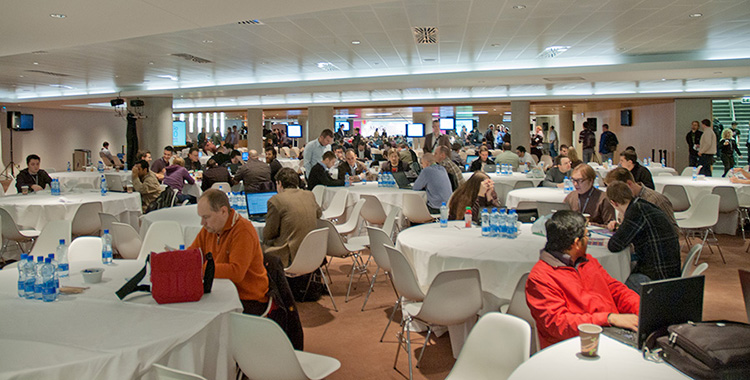
Central conference hall during the opening ceremony.
Aviva is the newly opened (spring 2010) stadium of the highest, fourth category of UEFA - the only stadium of this class in Ireland. Both outside and inside is an impressive size futuristic design with a capacity of 50 thousand people!
')

Main entrance Aviva Stadium.
The internal halls in which the conference itself takes place are not located in the most obvious way, but this brightens up with a completely amazing atmosphere - for the first time I get to the open source conference, and the informal, friendly atmosphere is strikingly different from regulated and formal events that usually come from large brands.

The opening speech in the morning of the first day was held by all sorts of people - both representatives of both IT giants, and people from the non-profit organization The Linux Foundation, which controls MeeGo, and prominent figures from the MeeGo community. For example, it was surprising to see speakers together Doug Fisher, vice president of Intel Software and Services Group, and Carsten Munch, an independent developer who supports the MeeGo development branch for the N900. Even more curious, at the very end of the opening ceremony, Chris Schlager, who runs AMD operating system development, promised AMD to join MeeGo in the strongest terms: “If you think GPU / CPU can't make a difference, beware” . As I wrote in the comments to the Bumburum announcement , at the opening ceremony, people from The Linux Foundation and independent developers spoke quite sharply a couple of times about the fact that corporations are helping the project, but they don’t run the show to immediately outline the spheres of influence - and after that, the situation in the hall was discharged, and those present with satisfied persons dispersed in sessions. All this really looks like real open collaboration, and not just empty marketing words.
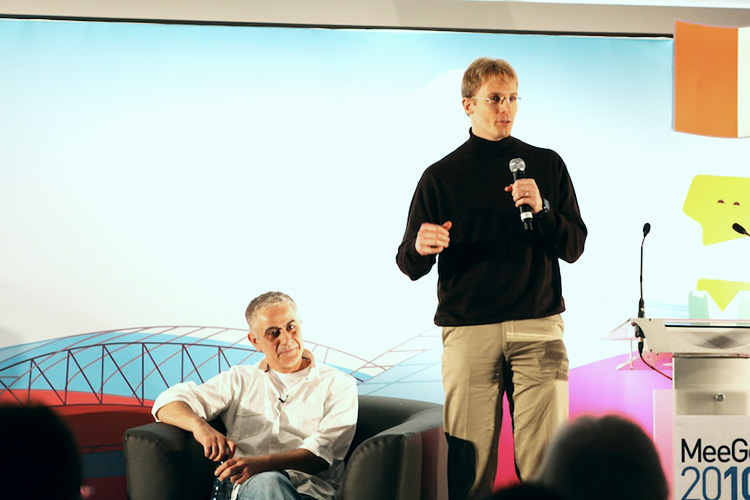
On the right is the sudden hero of the day from AMD; photo - David Gilson.
Session grid is quite intense; from nine in the morning until the middle of the evening, the performances run in parallel in five halls at once - fortunately, they are divided into topics and in time, so, for example, my conflict of interests arose only in a single session of three days. I go to interface and near-design sessions (because I myself have been working on interfaces for the past few years), Vyacheslav Chernikov, Intel ISN Migom to MeeGo conference winner, who won a trip to Dublin and came with me, is certified by Qt, which Nokia representatives right during the conference held in one of the halls of the stadium. In the evenings, there are sessions of Birds of Feather (in Russian, this is something like “one berry field”), they are more technical in nature and are aimed at people interested in some specific issue, for example, in the nuances of IVI development (in-vehicle infotainment), automotive electronics.
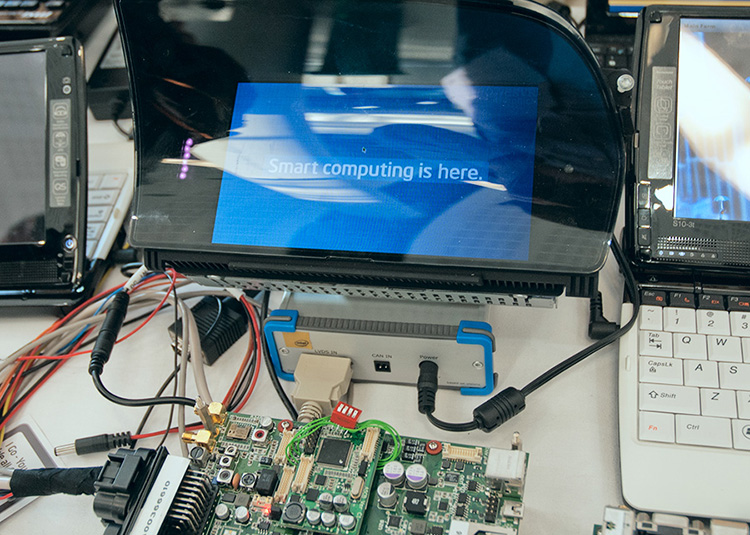
Glare in optics without a polarizing filter, but incredibly cool looking on closer inspection, the system of the screen and the polarization grid, which allows the driver to see one image on one side of the screen (for example, rear view), and the passenger on the other hand something completely different for example, a commercial of one well-known company (in the photo).
Almost immediately after the opening speech, Don Foster, the Intel Meego Community Manager, spoke about the community structure. Some interesting moments: firstly, the nine-month-old child MeeGo already has metrics , from which, for example, it follows that fewer than 8 thousand community members were registered in May, and nearly 15 thousand in October, that is, the community is growing quite actively and develops.
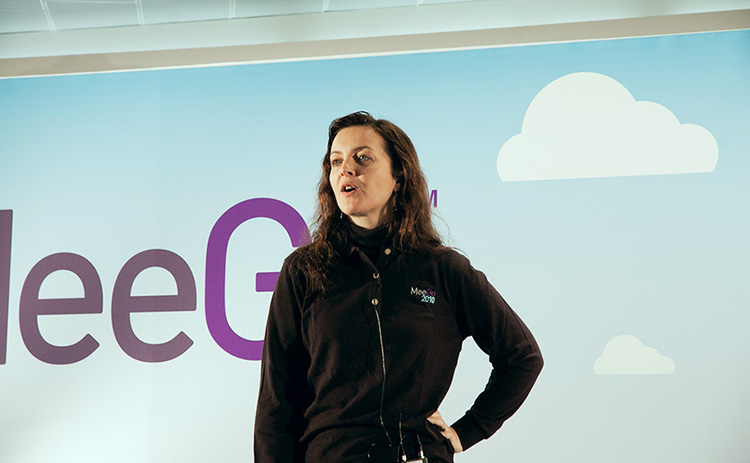
Don Foster
Secondly, the situation with the MeeGo roadmap cleared up a little bit - literally at the beginning of November a very modified version 1.1 was released , which is now being discussed at the conference; in half a year (at the end of May) the next conference will be held in San Francisco, and it will already concern release 1.2, which by and large will be the first more or less completed thing in itself. In the future, if you believe Don, this mechanic will continue: the release of the new version every six months, immediately after which a developer conference will be held. That does not cancel various local parties - for example, beautiful Finnish girls go around the conference, distribute Fazer candies and invite people to the MeeGo summit in Oulu in late May. Don mentioned that the main centers of the MeeGo community are in San Francisco, Dallas, Finland, India and China, so it is not surprising that the May conference is being held in San Francisco, and may move to China next November.
Russian developers are also at the conference, not only as visitors, but also as speakers - for example, Andrei wazd Zhilin , one of the developers of the OMWeather widget, met us, tomorrow he will share his findings on application design with fellow programmers.
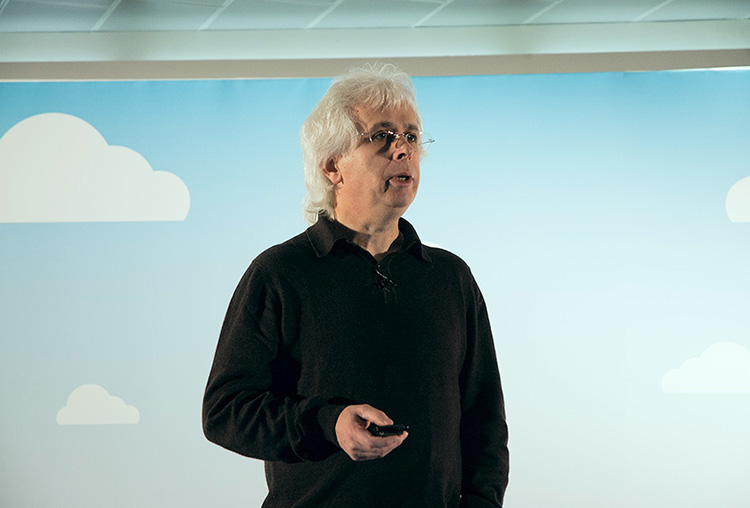
Dominique Le Foll.
The most impressive lecturer of the day is Dominique Le Voll, CTO of Amino , based in Cambridge in the UK and developing set-top boxes - or the interactive television of the future, if you like.

Set top box Amino Freedom.
In September, the presentation of Dominic was one of the brightest at IDF - he told how his company for 6 months developed a set-top box based on MeeGo. If you (like me) are not quite in the subject, then I’ll explain the scope of the task: this small inexpensive device based on the Intel Atom CE4100 that can play a wide variety of television streams encoded with a bunch of different codecs supports the most exotic digital content encryption protocols (DRM) , has a parental filter mandatory in many European countries, recognizes subtitles in a heap of different formats, downloads videos from the Internet (try switching from TV to YouTube without pauses to buffering!), speaks virtually any remote control, has a fully customizable (and even externally plug-in) interface, records TV programs, meets strict European standards of energy consumption, has remote administration functions for support engineers and automatic firmware upgrade and operating system functions that do not disturb users by pop-up windows, allows install and run applications (and even 3D shooters like Quake Arena - I played the Arena with my own hands with bullets that!) and, among other things, has an adequate security system. That is, once again: this is a TV + video player + game console + computer based on an energy-efficient processor and operating system, which nobody knew about in January. And all this for half a year! Thank you! Fantasy!

Family contract: Dominic's son Brendan Le Voll demonstrates one of the possible interfaces of Freedom - XBMC. Brendan himself screwed XBMC to Freedom for this demonstration at the conference.
I caught Dominic after the presentation and talked to him about his set-top box Amino Freedom. If you are interested, leave comments, I will tell you about the Freedom project and what Dominic and his team had to deal with in more detail. But if to summarize, then Amino most actively uses an impressive set of open source tools like Gstreamer, without which the project would not have happened in any half a year. Dominic separately praises the Gstreamer framework (and claims that, contrary to popular opinion, they can learn to use and save a lot of time on developing something like this) and the OBS toolkit (openSUSE Build Service), which saves the Amino team from the need for large-scale code rework after exiting the next semi-annual release of MeeGo. Amino sells its consoles worldwide; a curious fact: Dominic mentioned that one of his major clients is in Russia, and this is Comstar. Another curious fact: Dominic claims that more Intel employees than his people helped his development - of course, nothing of the kind could happen to any other Linux distribution, which is why Amino switched to MeeGo without much hesitation. delighted with both the operating system and support from the MeeGo community.
In parallel with the sessions, mini-exhibitions of various interesting pieces of iron are held. For example, the ICS guys show various sensors and data sources that connect to small devices like Lenovo IdeaPad netbooks that run MeeGo.
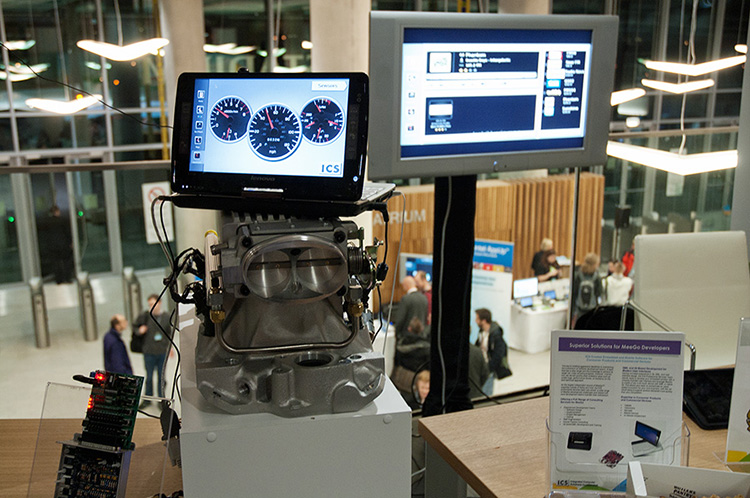
Demo of a conditional IVI device, which reads the readings from the sensors on the car engine and installed in the cabin. According to the assurance of people from ICS, the interface is promptly written in QML by a designer who knows how to photoshop, but who does not know how to program - QML is another one of the hot topics of the conference. The transitions between the screens look very, very smooth.

The glowing thing on the left is the FM receiver. On the right, respectively, is a really working interface from a car radio.
Tomorrow, in the morning, Vyacheslav runs cross with other conference participants, and I stock up on coffee and continue to monitor the situation. Please leave your questions - there is some very nice party, so everyone really wants to share everything in the best traditions of open source.

Central conference hall during the opening ceremony.
Aviva is the newly opened (spring 2010) stadium of the highest, fourth category of UEFA - the only stadium of this class in Ireland. Both outside and inside is an impressive size futuristic design with a capacity of 50 thousand people!
')

Main entrance Aviva Stadium.
The internal halls in which the conference itself takes place are not located in the most obvious way, but this brightens up with a completely amazing atmosphere - for the first time I get to the open source conference, and the informal, friendly atmosphere is strikingly different from regulated and formal events that usually come from large brands.

The opening speech in the morning of the first day was held by all sorts of people - both representatives of both IT giants, and people from the non-profit organization The Linux Foundation, which controls MeeGo, and prominent figures from the MeeGo community. For example, it was surprising to see speakers together Doug Fisher, vice president of Intel Software and Services Group, and Carsten Munch, an independent developer who supports the MeeGo development branch for the N900. Even more curious, at the very end of the opening ceremony, Chris Schlager, who runs AMD operating system development, promised AMD to join MeeGo in the strongest terms: “If you think GPU / CPU can't make a difference, beware” . As I wrote in the comments to the Bumburum announcement , at the opening ceremony, people from The Linux Foundation and independent developers spoke quite sharply a couple of times about the fact that corporations are helping the project, but they don’t run the show to immediately outline the spheres of influence - and after that, the situation in the hall was discharged, and those present with satisfied persons dispersed in sessions. All this really looks like real open collaboration, and not just empty marketing words.

On the right is the sudden hero of the day from AMD; photo - David Gilson.
Session grid is quite intense; from nine in the morning until the middle of the evening, the performances run in parallel in five halls at once - fortunately, they are divided into topics and in time, so, for example, my conflict of interests arose only in a single session of three days. I go to interface and near-design sessions (because I myself have been working on interfaces for the past few years), Vyacheslav Chernikov, Intel ISN Migom to MeeGo conference winner, who won a trip to Dublin and came with me, is certified by Qt, which Nokia representatives right during the conference held in one of the halls of the stadium. In the evenings, there are sessions of Birds of Feather (in Russian, this is something like “one berry field”), they are more technical in nature and are aimed at people interested in some specific issue, for example, in the nuances of IVI development (in-vehicle infotainment), automotive electronics.

Glare in optics without a polarizing filter, but incredibly cool looking on closer inspection, the system of the screen and the polarization grid, which allows the driver to see one image on one side of the screen (for example, rear view), and the passenger on the other hand something completely different for example, a commercial of one well-known company (in the photo).
Almost immediately after the opening speech, Don Foster, the Intel Meego Community Manager, spoke about the community structure. Some interesting moments: firstly, the nine-month-old child MeeGo already has metrics , from which, for example, it follows that fewer than 8 thousand community members were registered in May, and nearly 15 thousand in October, that is, the community is growing quite actively and develops.

Don Foster
Secondly, the situation with the MeeGo roadmap cleared up a little bit - literally at the beginning of November a very modified version 1.1 was released , which is now being discussed at the conference; in half a year (at the end of May) the next conference will be held in San Francisco, and it will already concern release 1.2, which by and large will be the first more or less completed thing in itself. In the future, if you believe Don, this mechanic will continue: the release of the new version every six months, immediately after which a developer conference will be held. That does not cancel various local parties - for example, beautiful Finnish girls go around the conference, distribute Fazer candies and invite people to the MeeGo summit in Oulu in late May. Don mentioned that the main centers of the MeeGo community are in San Francisco, Dallas, Finland, India and China, so it is not surprising that the May conference is being held in San Francisco, and may move to China next November.
Russian developers are also at the conference, not only as visitors, but also as speakers - for example, Andrei wazd Zhilin , one of the developers of the OMWeather widget, met us, tomorrow he will share his findings on application design with fellow programmers.

Dominique Le Foll.
The most impressive lecturer of the day is Dominique Le Voll, CTO of Amino , based in Cambridge in the UK and developing set-top boxes - or the interactive television of the future, if you like.

Set top box Amino Freedom.
In September, the presentation of Dominic was one of the brightest at IDF - he told how his company for 6 months developed a set-top box based on MeeGo. If you (like me) are not quite in the subject, then I’ll explain the scope of the task: this small inexpensive device based on the Intel Atom CE4100 that can play a wide variety of television streams encoded with a bunch of different codecs supports the most exotic digital content encryption protocols (DRM) , has a parental filter mandatory in many European countries, recognizes subtitles in a heap of different formats, downloads videos from the Internet (try switching from TV to YouTube without pauses to buffering!), speaks virtually any remote control, has a fully customizable (and even externally plug-in) interface, records TV programs, meets strict European standards of energy consumption, has remote administration functions for support engineers and automatic firmware upgrade and operating system functions that do not disturb users by pop-up windows, allows install and run applications (and even 3D shooters like Quake Arena - I played the Arena with my own hands with bullets that!) and, among other things, has an adequate security system. That is, once again: this is a TV + video player + game console + computer based on an energy-efficient processor and operating system, which nobody knew about in January. And all this for half a year! Thank you! Fantasy!

Family contract: Dominic's son Brendan Le Voll demonstrates one of the possible interfaces of Freedom - XBMC. Brendan himself screwed XBMC to Freedom for this demonstration at the conference.
I caught Dominic after the presentation and talked to him about his set-top box Amino Freedom. If you are interested, leave comments, I will tell you about the Freedom project and what Dominic and his team had to deal with in more detail. But if to summarize, then Amino most actively uses an impressive set of open source tools like Gstreamer, without which the project would not have happened in any half a year. Dominic separately praises the Gstreamer framework (and claims that, contrary to popular opinion, they can learn to use and save a lot of time on developing something like this) and the OBS toolkit (openSUSE Build Service), which saves the Amino team from the need for large-scale code rework after exiting the next semi-annual release of MeeGo. Amino sells its consoles worldwide; a curious fact: Dominic mentioned that one of his major clients is in Russia, and this is Comstar. Another curious fact: Dominic claims that more Intel employees than his people helped his development - of course, nothing of the kind could happen to any other Linux distribution, which is why Amino switched to MeeGo without much hesitation. delighted with both the operating system and support from the MeeGo community.
In parallel with the sessions, mini-exhibitions of various interesting pieces of iron are held. For example, the ICS guys show various sensors and data sources that connect to small devices like Lenovo IdeaPad netbooks that run MeeGo.

Demo of a conditional IVI device, which reads the readings from the sensors on the car engine and installed in the cabin. According to the assurance of people from ICS, the interface is promptly written in QML by a designer who knows how to photoshop, but who does not know how to program - QML is another one of the hot topics of the conference. The transitions between the screens look very, very smooth.

The glowing thing on the left is the FM receiver. On the right, respectively, is a really working interface from a car radio.
Tomorrow, in the morning, Vyacheslav runs cross with other conference participants, and I stock up on coffee and continue to monitor the situation. Please leave your questions - there is some very nice party, so everyone really wants to share everything in the best traditions of open source.
Source: https://habr.com/ru/post/108228/
All Articles